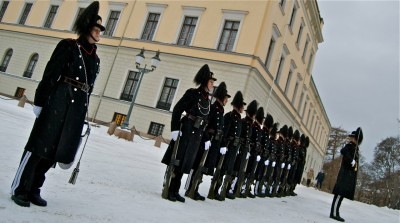They’re often referred to as “pyntsoldater” (decorative or ceremonial soldiers) who stand guard outside royal properties, march in parades and perform in international competitions. Norway’s royal guards, however, now may be called upon to respond to national emergencies in anything but dress uniform.

Officially called Hans Majestet Kongens Garde (His Majesty the King’s Guards) or, simply, Garden, they’re best known for standing outside the Royal Palace in Oslo and winning military tattoos around the world. They’ve become a tourist attraction over the years and long have been considered an example of elite duty, if not exactly tough.
That may change if Defense Chief Harald Sunde’s new long-term plans for the Norwegian military win political approval. His proposals are aimed mainly at improving military preparedness both at home and for participation in NATO exercises, and the royal guards play a major role in his new plans for Oslo.
Sunde has reversed his proposal of last year, reported by newspaper Aftenposten at the time, when he suggested that the royal guards would lose their military training and become purely ceremonial guard and parade soldiers. The proposal was unpopular and had it been implemented, the royal guards would not have been qualified to participate in the emergency response that followed last summer’s terrorist attack in Oslo. The royal guards changed into battle gear and joined the defense exercise, winning praise from then-Defense Minister Grete Faremo.
Upgrade with anti-terror training
Sunde has clearly recognized the role the guards can play and now wants to upgrade it. In addition to marching, standing guard and playing musical instruments, he wants the royal guards to be an important part of defense preparedness in Oslo, capable of carrying out advanced military operations on the streets of the Norwegian capital if necessary.
Exactly how advanced will be up to the state-appointed commission evaluating the emergency response to the terrorist attacks, and charged with making recommendations for improvement. “The assignments the military gets, after the commission has made its report, will determine that,” army chief Per Sverre Opedal told newspaper Aftenposten on Friday.
Uniform concerns
It’s likely, though, they’ll receive anti-terror training in addition to their regular military training. There will still be demand for their royal duties, though, which have led to other concerns of late. Newspaper Dagsavisen reported earlier this month that the military may outsource the sewing, mending and alterations work on the guard’s parade uniforms that’s now carried out in-house, at the guards’ base at Huseby in Oslo.
The goal is to save money, but Lt Col Odd Andreas Søbstad, who heads the guards unit, is worried. “We are a parade division with high standards,” he told Dagsvisen. “We cultivate precision. This proposal could be a catastrophe for us. We can’t end up with soldiers in parade uniforms that don’t fit properly.”
Lt Col Øivind Sjuls, in charge of procurement, tried to reassure Søbstad, calling the current alterations staffers “very clever” and “specialized.” He can’t rule out their department will survive indefinitely, but claimed no outsourcing is imminent.
Views and News from Norway/Nina Berglund
Please support our stories by clicking on the “Donate” button now:

